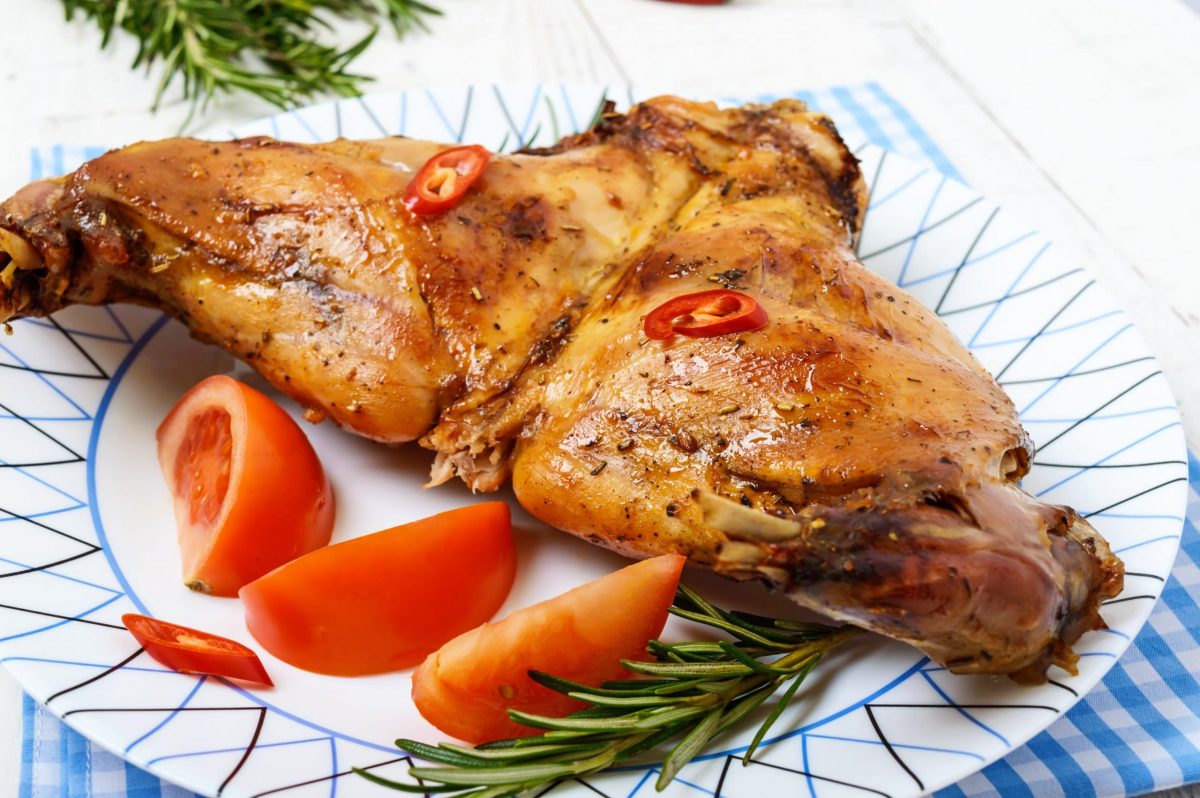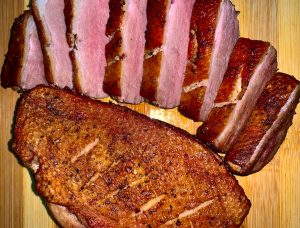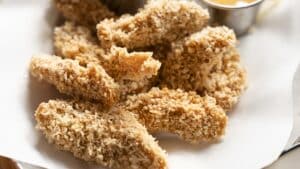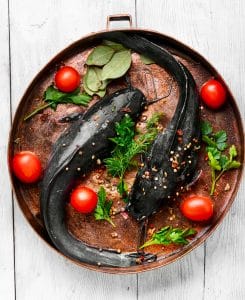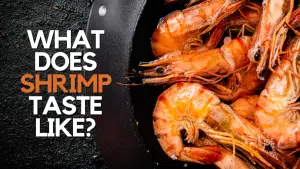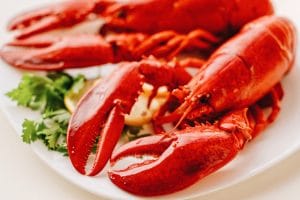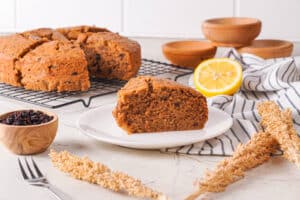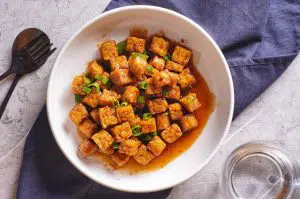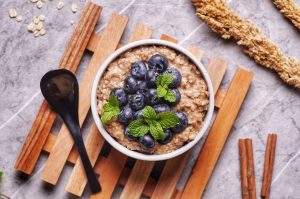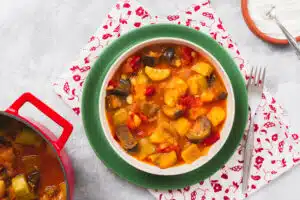What Does Rabbit Taste Like?
Important Note: When you buy through our links, we may earn a commission. As an Amazon Associate we earn from qualifying purchases. Content, pricing, offers and availability are subject to change at any time - more info.
Rabbit is often referred to as an exotic meat in the United States. But it is pretty common in many parts of the world, with the largest consumers in Australia, New Zealand, and Polynesia. In addition, it is the 5th most consumed meat in India and fairly popular in Britain. But what does it taste like?
Rabbit is a white meat with a gamier and more intense taste than chicken. Farm-raised rabbit has a fattier meat. Wild rabbit is leaner and harder, with more flavor. Both varieties are easy to chew, low in calories, and high in protein. It is commonly braised, stewed, or roasted.
Health-conscious people often limit themselves to lean proteins such as chicken, turkey, and fish. But rabbit’s robust flavor can breathe new life into stews and other winter dishes, along with a nutritional punch. It is also a more environmentally-friendly choice than many other protein sources. However, the taste will depend on where you get it and how it is prepared.
- What Does Rabbit Taste Like?
- Is Rabbit Safe To Eat?
- Can You Starve If You Eat Rabbit?
- What Are The Cuts Of Rabbit?
- Can You Soak Rabbit?
- What Spices Work Best With Rabbit?
- What Are The Best Ways To Prepare Rabbit?
- Is Rabbit Meat Healthy?
- Is Rabbit Meat Environmentally Friendly?
- Why Don’t More Americans Eat Rabbits?
- So, What Does Rabbit Taste Like?
What Does Rabbit Taste Like?
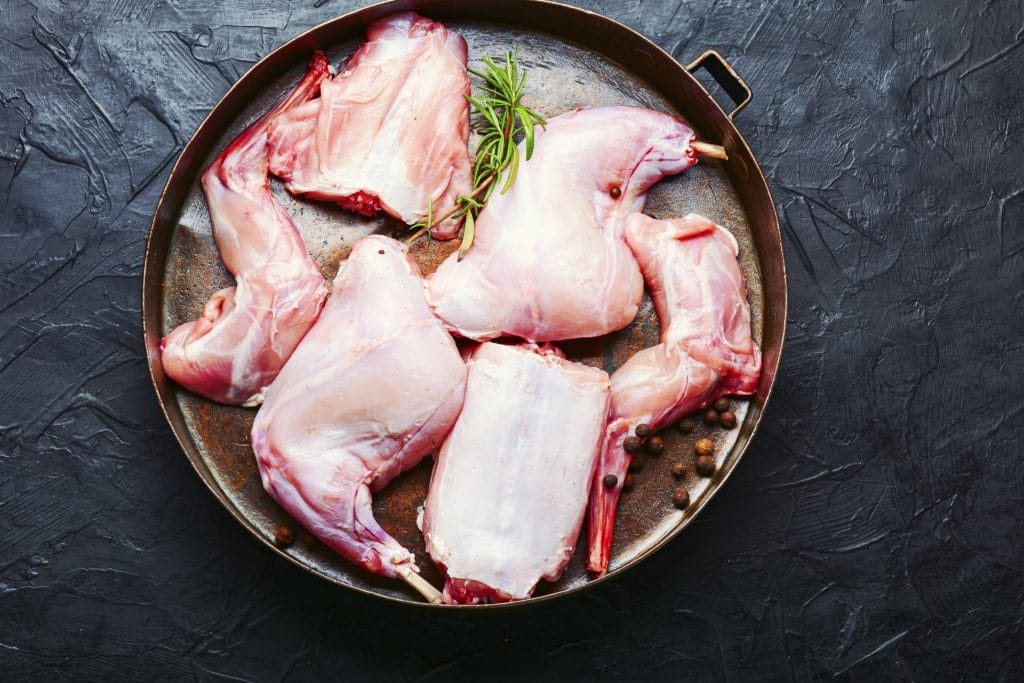
Rabbit is the venison version of poultry. It is drier due to having less fat than chicken but more protein. But it has a broader flavor and aroma that makes it feel like a heartier meal. The taste of the meat is impacted by breed, cooking method, age of the animal when harvested, and if it is from a farm or the wild.
Popular breeds are California rabbit, cinnamon rabbit, and silver fox. These are domestic breeds that in the United States would need to be purchased at specialty markets or from online exotic meat sellers.
What Does Farm Rabbit Taste Like?
Farm rabbits are domestic breeds where the taste will have greater consistency. Buyers can select their choice based on breed. Also, since the meat is being managed, it will not be stiffed by the animal’s prolonged maturity. They tend to be butchered between 8 – 12 weeks. However, some are over 6 months old before they are sold for meat.
Thus, farm rabbits have a light and pinker color to their meat, which is more tender than their wild cousins. This gives farm rabbits a lighter taste.
What Does Wild Rabbit Taste Like?
Wild rabbits live free and thus move around more and eat a leaner diet. Therefore, even if caught well before they are old, wild rabbits will have less tender meat that is darker in color. The advantage is that they have less fat and, for those that enjoy it, a stronger flavor.
However, the comparison between tenderness is relatively speaking. Even wild rabbits are much softer and easier to chew meat than many others. It is juicier than turkey but with a denser, heavier texture than chicken when appropriately prepared.
Is Rabbit Safe To Eat?
Rabbit is safe to eat so long as it is fully cooked. Hunting rabbits is where there is the highest risk of animal to human transfer of undesirable infection or pests. However, the risk can be minimized by wearing flea and tick spray, proper clothing, and putting on latex gloves before handling the kill. Also, don’t eat the main digestive tract, such as the stomach and intestines.
Farm-reared rabbits will have been treated for ticks, fleas, and parasites. Thus, the meat is very safe. However, it is still not suitable to be eaten raw. It must be fully cooked.
Can You Starve If You Eat Rabbit?
Starving from eating rabbits isn’t impossible, but it requires an extreme situation. The phenomenon is known as protein poisoning but is often referred to as rabbit starvation. This comes from a diet devoid of carbs and fat, which isn’t usually an issue for people living a modern lifestyle.
However, if you are trapped in the woods and can’t find anything other than rabbits, you must eat more than just the main meat. Boiling the bones to extract the marrow is a great way to add fats. The liver and brains are also excellent fat sources. This is also true if trying to survive off other lean wild meats, such as bison.
But as we mentioned, if you are eating a healthy diet that includes vegetables, this isn’t an issue. Also, farmed rabbits have more fat than wild rabbits. This is comparatively speaking, as even farmed rabbits produce lean meat. But that slight difference in fat would make a survivalist’s situation much easier.
However, if this still concerns you, add some truffle oil or butter to your vegetables.
What Are The Cuts Of Rabbit?
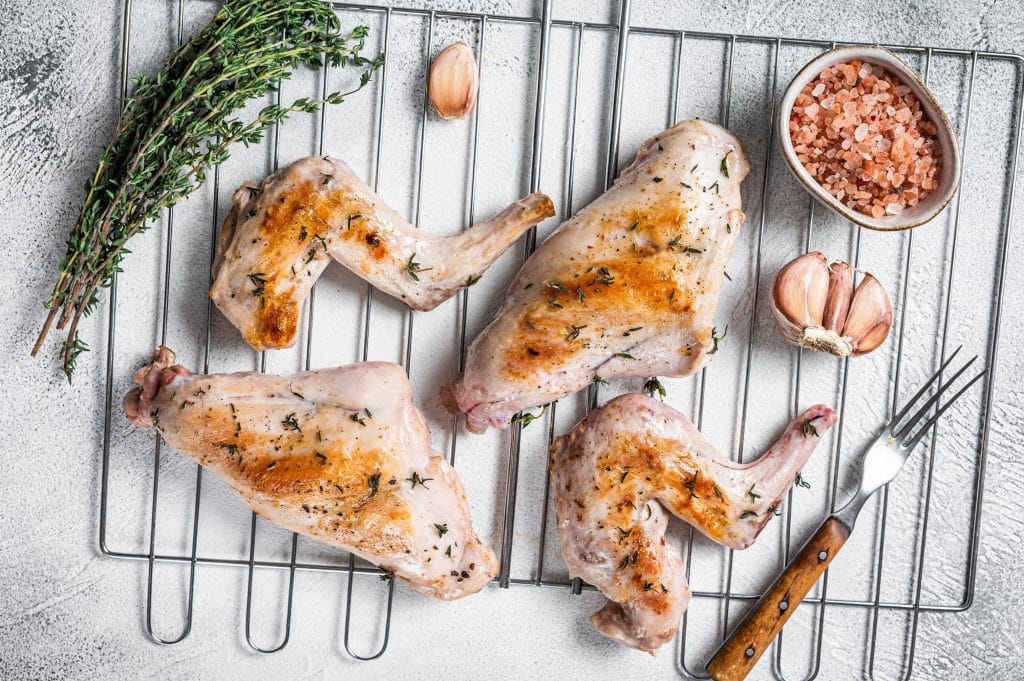
Rabbit meat is typically sold whole, although fully dressed. Butchers will cut it into portions, however, when requested. Should you be able to buy it in cuts, the most tender pieces are the saddle and loin. The hind legs are the toughest. Front legs and pelvis have little meat and are generally used for stock in soups and stews or to make a sauce.
Can You Soak Rabbit?
Some cooks prefer soaking a rabbit before preparation, especially if it came from the wild. It reduces the gamey flavor, helps it retain its juices, and tenderizes the meat. However, it isn’t a must, especially if farm-raised.
The practice of soaking rabbits comes from cooking hare. While hare and rabbit are related, hare has a different taste and distinctly different odor. The smell of hare is a bit much, and soaking it helps reduce it. On occasion, a rabbit may have a rather notable scent. This occurs in males, and soaking it overnight will eliminate the unwanted fragrance.
Three hours of soaking is sufficient for a tender, non-smelly rabbit to give it that extra juicy touch. For a wild rabbit or strongly male one, overnight is preferred. Popular soaking solutions can be as simple as plain water to a mixture that resembles heavily diluted marinade.
Common examples include:
- Brine
- Milk
- Olive oil and spices
- Paprika
- Plain water
- Sour cream
- Vinegar, diluted
- Water with lemon, lime, or orange
- Wine
- Wine with herbs
What Spices Work Best With Rabbit?
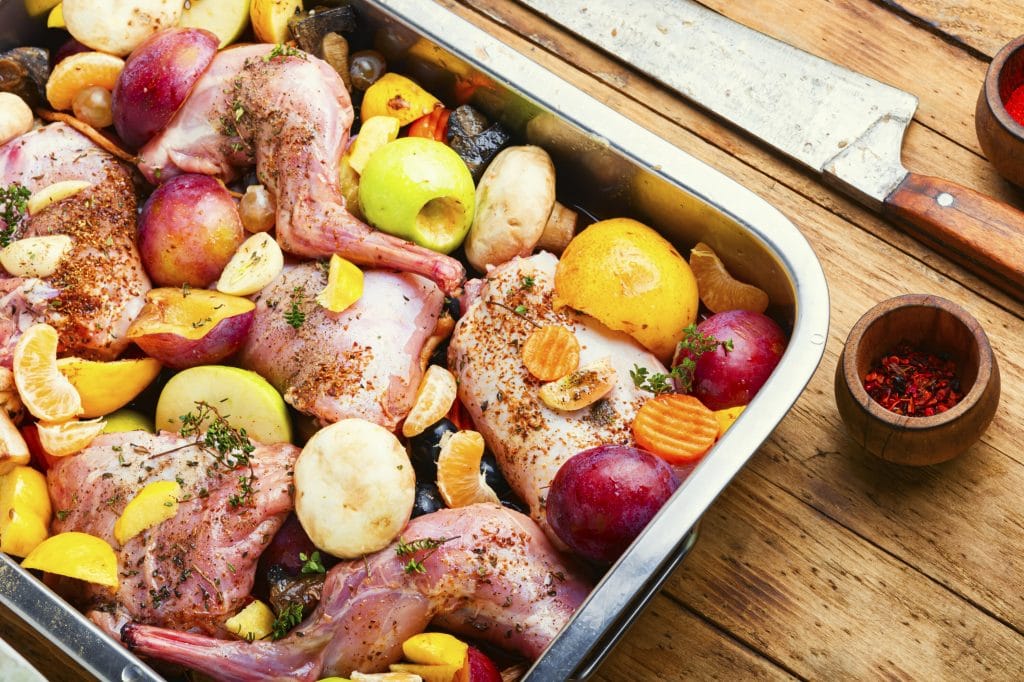
Like chicken, rabbit is incredibly versatile when it comes to seasonings. It works beautifully in curries and many Mexican dishes, including mole sauce. But it is equally fantastic with more North American and European dishes. Wine or fruit-based sauces are also incredibly popular when preparing rabbit.
Common seasonings include:
- Basil
- Bay leaf
- Black pepper
- Garlic
- Lemongrass
- Marjoram
- Parsley
- Rosemary
- Sage
- Thyme
Marinating the rabbit an hour or few in the herbs and spice with olive oil will increase the flavor, tenderness, and juiciness.
Marinades are often combinations of seasonings, herbs, and soaking options. Also, grape juice can be an excellent alternative to wine; just add a few splashes of vinegar to provide the non-alcoholic edge.
Less common but fun marinades have been made from:
- Beer
- Cider
- Chicken broth
What Are The Best Ways To Prepare Rabbit?

Rabbit can be prepared in many ways, including fried, grilled, baked, roasted, sautéed, stewed, braised, and even candied. However, it is prone to drying out because it is a lean meat. Fortunately, it responds well to marinades and is stunning in soups, stews, and braised. These methods help bring out its juicy and robust flavor.
Thus, the most popular recipes featuring rabbits are stews and braising. Cooking rabbits with these methods doesn’t require extra oil, perfect for people who need to keep their fats and cholesterol intake low. These styles also help prevent the meat from becoming dry, an issue many people struggle with when new to cooking rabbit.
The fastest way to cook rabbit is by frying. It is essentially the same frying process you use with chicken. It takes about 20 min, based on the amount of fat in the animal’s joints. If there is less fat, the cooking time is less. Deep frying recipes are also similar to chicken, including using buttermilk to soak or as part of the batter.
Slow-cooking rabbit is where the meat truly shines. Braising, slow cookers, and slow roasting methods can take between 1 – 6 hours. But, done right, the meat will be tender and juicy, cooked all the way through.
It is good to ask your butcher the age of the rabbit before purchasing or let them know what it is you wish to prepare. For example, if you are frying, you want them 8-10 weeks old. Roasting also should be fairly young meat, up to 12 weeks old.
On the other hand, if it is a stew that’s on the menu, you can use meat that was butchered as late as 8 months and still get tender results, provided it is slow-cooked.
If the rabbit was hunted instead of farmed, slow cooking methods after soaking are best.
Is Rabbit Meat Healthy?
Rabbit is an incredibly healthy protein source for people on low fat or low-calorie eating plans. It is an excellent addition to diets that have been mostly confined to chicken and fish. For instance, 3-ounces of rabbit has 96 calories, whereas the same serving of chicken is 94. Thus, the calorie content is virtually the same with a higher nutritional punch.
Part of rabbit meat’s low-calorie content is due to 72% of it being made up of water. It also has a glycemic value of 0. It also has around a quarter less cholesterol than chicken and around half as less as beef and pork.
Rabbit Is An Excellent Source Of Protein
Rabbit is a high protein source. A 3.5-ounce portion of rabbit will supply 40% of your daily protein needs, and wild rabbit provides 44%. This is thanks to rabbit meat averaging over 20% of it being protein. That’s nearly double what pork provides and edges out beef and chicken, too.
Rabbit Is An Excellent Source Of Vitamins And Minerals
Rabbit is packed with vitamins and minerals. It is one of the highest-rated meats for iron and calcium. It also contains a lot of phosphorus, B complex vitamins, and vitamin E. However, it is a poor source of vitamin A, C, and D.
It is important to note that farm rabbit does not have the same nutritional profile as wild rabbit. Some of this has to do with the slightly higher fat content, what they eat, and how they spend their days before being used for meat.
| Nutrition | Wild Rabbit’s Daily Value 3.5 oz | Farm Rabbit Daily Value 3.5oz |
| B1 (Thiamin) | — | 8% |
| B2 (Riboflavin) | 5% | 12% |
| B3 (Niacin) | 41% | 45% |
| B5 | — | 16% |
| B6 | — | 29% |
| B12 | — | 298% |
| Iron | 18% | 9% |
| Magnesium | 7% | 5% |
| Phosphorus | 18% | 17% |
| Potassium | 8% | 7% |
| Protein | 44% | 40% |
| Selenium | 17% | 43% |
| Zinc | 14% |
As you can see, farm-reared rabbit contains a greater variety of nutrients than wild rabbit. However, there are areas where wild rabbit out paces the farm-reared. Nonetheless, both are healthy choices.
Is Rabbit Meat Environmentally Friendly?

If you are going to eat meat, rabbit is a more environmentally sustainable choice than many other animal protein sources. For example, our global fish stocks are under severe strain, making rabbit a far better environmental choice. Whereas rabbits breed easily and quickly, nor are they in danger of becoming extinct.
Also, they are easy to raise and don’t require as many resources as many other farmed proteins. For instance, when comparing cows and rabbits for a like-to-like ratio of feed intake to meat produced, a rabbit will give 6 pounds and a cow a mere pound. Nor do rabbits take up as much space or have as high of a carbon footprint.
Rabbits are also inexpensive to raise, compared to most farmed animals. Chickens, however, are often a bit cheaper. However, rabbits are quieter than chickens, require less space, and are tidier, making them easier to clean up after. Their droppings also don’t need to be composted before adding them to the garden.
When it comes to harvesting the meat, rabbits are easier and quicker than chickens too. However, bunnies don’t lay eggs.
Why Don’t More Americans Eat Rabbits?
It does seem odd that the meat isn’t more popular, given rabbit is both healthier and easier on the environment than most animal protein sources. Nor can the avoidance be blamed on taste, given how similar it is to chicken.
The reason many people resist eating rabbit is that they are both cute and one of the most popular companion pets in the United States after dogs and cats. Thus, supermarkets that have tried to sell it stop due to public outrage. That said, rabbits are far less intelligent than a pig.
So, What Does Rabbit Taste Like?
Rabbit is an excellent alternative to chicken, with a more robust flavor. It is a brilliant source of protein and packed with other essential nutrients. The meat is versatile and can be cooked in a wide range of herbs and spices. However, it does best with slow-cooking methods. Braising and stews will help the meat remain juicy and ensure it is tender.
